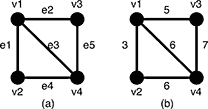POJ
来源:互联网 发布:人工智能 估值 编辑:程序博客网 时间:2024/06/05 02:51
Description
Given an undirected weighted graph G, you should find one of spanning trees specified as follows.
The graph G is an ordered pair (V, E), where V is a set of vertices {v1, v2, …, vn} and E is a set of undirected edges {e1, e2, …, em}. Each edge e ∈ E has its weight w(e).
A spanning tree T is a tree (a connected subgraph without cycles) which connects all the n vertices with n − 1 edges. The slimness of a spanning tree T is defined as the difference between the largest weight and the smallest weight among the n − 1 edges of T.

Figure 5: A graph G and the weights of the edges
For example, a graph G in Figure 5(a) has four vertices {v1, v2, v3, v4} and five undirected edges {e1, e2, e3, e4, e5}. The weights of the edges are w(e1) = 3, w(e2) = 5, w(e3) = 6, w(e4) = 6, w(e5) = 7 as shown in Figure 5(b).

Figure 6: Examples of the spanning trees of G
There are several spanning trees for G. Four of them are depicted in Figure 6(a)~(d). The spanning tree Ta in Figure 6(a) has three edges whose weights are 3, 6 and 7. The largest weight is 7 and the smallest weight is 3 so that the slimness of the tree Ta is 4. The slimnesses of spanning trees Tb, Tc and Td shown in Figure 6(b), (c) and (d) are 3, 2 and 1, respectively. You can easily see the slimness of any other spanning tree is greater than or equal to 1, thus the spanning tree Td in Figure 6(d) is one of the slimmest spanning trees whose slimness is 1.
Your job is to write a program that computes the smallest slimness.
Input
The input consists of multiple datasets, followed by a line containing two zeros separated by a space. Each dataset has the following format.
Every input item in a dataset is a non-negative integer. Items in a line are separated by a space. n is the number of the vertices and m the number of the edges. You can assume 2 ≤ n ≤ 100 and 0 ≤ m ≤ n(n − 1)/2. ak and bk (k = 1, …, m) are positive integers less than or equal to n, which represent the two vertices vak and vbk connected by the kth edge ek. wk is a positive integer less than or equal to 10000, which indicates the weight of ek. You can assume that the graph G = (V, E) is simple, that is, there are no self-loops (that connect the same vertex) nor parallel edges (that are two or more edges whose both ends are the same two vertices).
Output
For each dataset, if the graph has spanning trees, the smallest slimness among them should be printed. Otherwise, −1 should be printed. An output should not contain extra characters.
Sample Input
4 51 2 31 3 51 4 62 4 63 4 74 61 2 101 3 1001 4 902 3 202 4 803 4 402 11 2 13 03 11 2 13 31 2 22 3 51 3 65 101 2 1101 3 1201 4 1301 5 1202 3 1102 4 1202 5 1303 4 1203 5 1104 5 1205 101 2 93841 3 8871 4 27781 5 69162 3 77942 4 83362 5 53873 4 4933 5 66504 5 14225 81 2 12 3 1003 4 1004 5 1001 5 502 5 503 5 504 1 1500 0
Sample Output
1200-1-110168650
求一棵树 要求最长的枝与最短的枝之间的差 最小 。
暴力求解,不过测试数据很小,即使暴力,20ms也过了。真是迷。。
#include<iostream>#include<cstdio>#include<algorithm>#include<queue>#include<cmath>#include<vector>#include<map>using namespace std;#define min(a,b) ((a)>(b)?(b):(a))#define MAX 1000000000int UFS[108];int UFS_find(int x){ if(x!=UFS[x]) UFS[x]=UFS_find(UFS[x]); return UFS[x];}void UFS_insert(int x,int y){ x=UFS_find(x); y=UFS_find(y); UFS[max(x,y)]=min(x,y);}struct AP{ int x,y,value;};bool comp(AP a,AP b){ return a.value<b.value;}int main(){ int n,m; while(cin>>n>>m&&(n!=0||m!=0)) { AP in[5555]; for(int i=0; i<m; i++) cin>>in[i].x>>in[i].y>>in[i].value; sort(in,in+m,comp); int com[108]= {},MIN=MAX; for(int i=0; i<m; i++) { for(int j=1; j<=n; j++) UFS[j]=j; int T=n-1,sum=0,ans=0; for(int j=i; j<m; j++) if(UFS_find(in[j].x)!=UFS_find(in[j].y)) { UFS_insert(in[j].x,in[j].y); sum++; if(in[j].value-in[i].value>=MIN) break; if(sum==T) { MIN=min(MIN,in[j].value-in[i].value); break; } } if(MIN==MAX) break; } if(MIN!=MAX) cout<<MIN<<endl; else cout<<"-1"<<endl; } return 0;}- POJ
- poj
- POJ
- POJ
- poj
- poj
- POJ
- POJ
- poj
- POJ
- POJ
- POJ
- POJ
- POJ
- POJ
- POJ
- POJ
- POJ
- 嵌入式应届生毕业六个月后月薪1w4,是什么水平?
- Linux网络编程“惊群”问题总结
- python 之socket编程(TCP)
- 2017CCPC网络赛1005 hdu6154 CaoHaha's staff
- Spark 分层抽样与求最大值最小值
- POJ
- 数据库部分
- 4.S5PV210串口通信详解(二)
- Extreme公司准备购买博科数据中心网络业务
- Hibernate-Inverse属性
- 设计模式之状态模式
- 【C#学习】访问限制修饰符
- fzu 2113 Jason的特殊爱好
- 考前定位(中)


